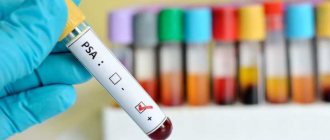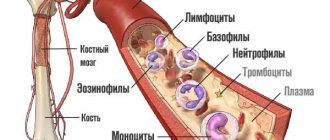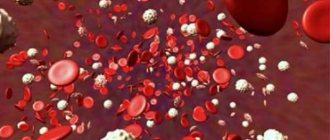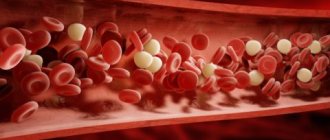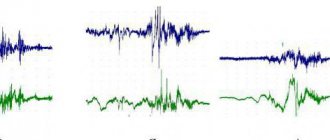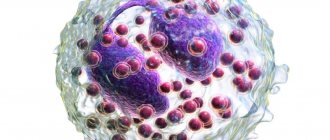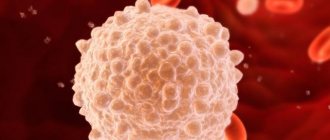A coagulogram (otherwise known as a hemostasiogram) is a special study that shows how well or poorly a person’s blood clotting occurs.
This analysis plays a very important role in determining a person's condition. Its indicators help predict how the operation or childbirth will go, whether the patient will survive, and whether it is possible to stop the bleeding of the wounded.
True, not all doctors have the ability to read a coagulogram. However, sometimes this research can save a person’s life.
What does the APTT test show?
APTT, the norm for women by age is discussed in the article, is an accurate indicator for identifying blood clotting disorders. The essence of the analysis is to determine the clotting time of plasma when the natural process is activated “in vitro” in the presence of special reagents.
APTT allows you to measure the effectiveness of stopping bleeding by internal and general mechanisms. In the first case, this occurs in the absence of tissue damage. Tissue factor is required to initiate the extrinsic mechanism that leads to the formation of a blood clot.
At the final stage, these 2 mechanisms combine (common coagulation pathway), which ultimately promotes the formation of thrombin and fibrin, which “clog” the vessel and prevent blood loss. Subsequently, when the damaged tissue is restored, a reverse mechanism is launched, promoting the dissolution of the blood clot.
Coagulogram - what kind of analysis is this?
Patients often wonder what a blood coagulogram is, for example, before surgery or during pregnancy, and why is it so important to take it?
A coagulogram is a medical analysis to assess the state of the system that starts and stops the blood clotting mechanism.
The obligatory examination before surgery is due to the possible risk of bleeding during surgery. If failures in the hemostatic system are detected, the patient may be denied surgical intervention if the risk of bleeding is too great. In addition, the inability to carry out one of the coagulation mechanisms can be the cause of miscarriage.
The effectiveness of therapy for any pathology affecting the hemostatic system requires strict control and is implemented through the examination in question. Positive dynamics indicate the correctness of the chosen tactics and a favorable outcome. Lack of improvement requires immediate correction of the treatment regimen by a specialist.
What is included in a blood coagulogram?
Coagulogram parameters: prothrombin index (PTI), international normalized ratio (INR), fibrinogen protein, antithrombin (AT III), activated partial thromboplastin time (APTT) and protein fragment (D-dimer).
PTI and INR
Using two parameters - PTI and INR, it is possible to assess the normal functioning of the external and general pathway for blood coagulation. In the case of a decrease in the concentration of protein factors in the serum of the subject, a deviation of the considered criteria is observed to be greater than the norm.
It has been established that prothrombin is produced by liver cells (hepatocytes) and requires vitamin K for its normal functioning. In case of its hypofunction (deficiency), a failure occurs in the formation of a blood clot. This fact underlies the treatment of people with a predisposition to thrombosis and cardiovascular pathologies. The essence of treatment is to prescribe drugs that interfere with the normal synthesis of the vitamin. Both criteria under consideration are used to determine the degree of effectiveness of these tactics.
Formula for calculating prothrombin index:
, Where
PTI std. – the amount of time it takes for plasma to clot in the control sample after adding clotting factor III.
The INR coagulogram is calculated using the following formula:
,Where
ISI (International Sensitivity Index) is a standard coefficient.
It is known that the values under consideration are characterized by an inverse correlation, that is, the higher the prothrombin time index, the lower the INR. The statement is also true for the inverse relationship.
Fibrinogen
Fibrinogen protein synthesis occurs in hepatotocytes. Under the influence of biochemical reactions and degrading enzymes, it takes an active form in the form of fibrin monomer, which is part of the blood clot. Protein deficiency can be due to two reasons: congenital genetic mutations and excessive depletion for biochemical reactions. This condition is characterized by excessive bleeding and poor blood clotting.
In addition, when tissue integrity is damaged as a result of mechanical damage or inflammatory processes, fibrinogen production increases significantly. Measuring protein concentration allows you to diagnose pathologies of the cardiovascular system (CVS) and liver, as well as assess the risk of possible complications.
Main article: Norms and reasons for increased fibrinogen in the blood of an adult, incl. during pregnancy
AT III
AT III is one of the most important factors, the main producers of which are hepatocytes and endothelium, which lines the internal cavity of blood vessels. The main function is to suppress coagulation processes by inhibiting the functioning of thrombin. Thanks to the normal ratio of these two proteins, stable hemostasis is achieved. Insufficient synthesis of antithrombin leads to increased coagulation processes and a critical level of thrombosis.
APTT
APTT in a coagulogram is a criterion that allows one to evaluate the normal implementation of the internal pathway. Its duration is directly dependent on the concentration of kininogen (precursor of polypeptides) and various protein coagulation factors.
The APTT value is determined by measuring the time it takes to form a full-fledged blood clot when reagents are added to the test sample. Deviation of the criterion to a greater extent than the norm leads to an increase in the frequency of bleeding, and to a lesser extent – to excessive formation of blood clots. In addition, isolated use of aPTT is acceptable in order to reliably monitor the effectiveness of the use of anticoagulant drugs.
D-dimer
Normally, a blood clot should undergo destruction (destruction) over time. By measuring the D-dimer value it is possible to determine the efficiency and completeness of this process. In case of incomplete dissolution of the thrombus, an increase in the criterion is noted. In addition, the use of D-dimer to monitor the effectiveness of anticoagulant treatment is acceptable.
When is a test ordered?
An analysis to determine APTT is prescribed in the following cases:
- Screening examination of healthy people to identify the risk of diseases.
- Analysis of pathologies of the blood coagulation system. An enzymatic imbalance (including congenital) can lead to diseases such as thromboembolism (blockage of a blood vessel by a detached blood clot), ischemia and infarction of various organs, including the brain; atherosclerosis and other cardiovascular diseases, immune and oncological diseases. If they are present, the patient requires periodic monitoring of the APTT.
- Definition of disseminated intravascular coagulation (DIC), in which a pathological process of thrombus formation in small blood vessels occurs in the body in combination with poor blood clotting, which leads to massive hemorrhages. Often this disease is asymptomatic.
- Diagnosis of hemophilia, which is a genetically determined pathology. Such people have an increased risk of severe blood loss even with minor trauma, since the blood has a very low ability to clot. Often hemorrhages occur in joints, muscle tissue, internal organs and the brain. Increased bleeding with minimal damage is detected from the first days of life.
- Monitoring the condition of the blood during treatment with drugs that have an anticoagulant effect, in particular heparin. The latter is used to treat patients diagnosed with thrombosis, pulmonary embolism, unstable angina, acute myocardial infarction, atrial fibrillation, DIC, Gasser's disease, mitral heart disease, inflammation of the heart muscle, glomerular and lupus nephritis. This drug is also prescribed for preventive purposes during operations with extracorporeal circulation, hemodialysis (blood purification) and some other medical procedures.
- Detection of antiphospholipid syndrome - an autoimmune disease in which blood clotting activity increases, which provokes thrombus formation. It is determined by the presence of lupus anticoagulant. In pregnant women, this pathology leads to an increased risk of spontaneous abortions, as well as thrombosis.
- Diagnosis of Hageman's disease. This is a very rare hereditary disease in which the activity of one of the clotting factors is reduced. It is characterized by the development of thrombosis or hemorrhagic syndrome.
- Diagnosis of von Willebrand disease. This is a hereditary disease in which spontaneous bleeding occurs due to insufficient activity of one of the factors involved in the clotting process. This pathology is characterized by prolonged bleeding, which poses a threat to the patient’s life. One of the characteristic symptoms is bleeding from the mucous membranes of the mouth and nose, spontaneous occurrence of bruises on the skin due to impaired vascular permeability. Women also experience heavy uterine bleeding lasting more than 10 days, as well as massive blood loss during childbirth. Exacerbations may alternate with periods of relative well-being.
APTT, the norm in women by age varies within the limits established by WHO, is also monitored during pregnancy every 3 months.
This is due to changes in the level of hormones that affect the circulatory system, as well as an increased risk of complications (miscarriage, stillbirth, premature birth, preeclampsia) in those patients for whom pathologies in the coagulation system have already been diagnosed.
Coagulogram during pregnancy
During pregnancy, colossal changes occur in a woman’s body, affecting all systems, including the hemostatic system. These changes are due to the appearance of an additional circulation (uteroplacental) and changes in hormonal status (prevalence of progesterone over estrogens).
During pregnancy, the activity of coagulation factors increases, especially 7,8,10 and fibrinogen. Fibrin fragments are deposited on the walls of the blood vessels of the placental-uterine system. The fibrinolysis system is suppressed. In this way, the woman’s body tries to protect itself in the event of uterine bleeding and miscarriage, and prevents placental abruption and the formation of intravascular blood clots.
Indicators of hemostasis during pregnancy
| Index | 1st trimester | 2nd trimester | 3rd trimester |
| Fibrinogen, g/l | 2,91-3,11 | 3,03-3,46 | 4,42-5,12 |
| APTT, s | 35,7-41,2 | 33,6-37,4 | 36,9-39,6 |
| AVR, with | 60,1-72,6 | 56,7-67,8 | 48,2-55,3 |
| Prothrombin index, % | 85,4-90,1 | 91,2-100,4 | 105,8-110,6 |
| RFMK, ED | 78-130 | 85-135 | 90-140 |
| Antithrombin III, g/l | 0,222 | 0,176 | 0,155 |
| Platelets, *109/l | 301-317 | 273-298 | 242-263 |
In pathological pregnancy (early and late gestosis), disturbances in the regulation of blood coagulation occur. The life of platelets is shortened and fibrinolytic activity increases. If a woman does not consult a doctor and treatment of gestosis is not carried out, a very serious complication arises - disseminated intravascular coagulation syndrome.
DIC syndrome or intravascular disseminated coagulation syndrome consists of 3 stages:
- hypercoagulation - the formation of many small blood clots, impaired blood circulation between mother and fetus;
- hypocoagulation - over time, coagulation factors are depleted in the blood, blood clots disintegrate;
- acoagulation - absence of blood clotting, uterine bleeding occurs, which threatens the life of the mother, the fetus in most cases dies.
Author:
Selezneva Valentina Anatolyevna physician-therapist
Norms of indicators by age
The normal APTT value is 25-38 seconds. It depends on the characteristics of the set of reagents, so each laboratory, when undergoing an examination, indicates the reference values that are contained in the passport of the medical diagnostic system.
This type of analysis is not standardized by the World Health Organization, since it uses various chemical compounds (animal or plant phospholipids, a mixture of them; phospholipids obtained from human blood cells). APTT norms are also not classified by the patient’s age, since there are no pronounced changes in this indicator.
Among women
Physiological changes in APTT values may occur during pregnancy and menstruation. During this period, the indicator drops to 18 seconds. A very low value is accompanied by the risk of blood clots forming in the vessels of the placenta, which can lead to abruption and miscarriage.
APTT in the blood test, normal in the table.
With a high APTT, intrauterine bleeding may develop, which also threatens the life of the fetus and the woman herself.
In men
For men, the norm remains the same - within 25-38 seconds. Conditions under which a decrease or increase in aPTT may occur are described below.
In children
The rate of activated partial thromboplastin time for children corresponds to that for adults. However, in newborns, and especially in premature infants, it typically increases by 3-5 seconds.
Blood coagulogram indicators: norms for adults and children Table
| Indicators | for men | for women | for pregnant women | in children (by age) | |
| Fibrinogen | 2-4 g/l | No more than 6 g/l | 1.25–3 g/l | ||
| APTT | 24-35 seconds | 14-20 s | 24-35 s | ||
| Lupus anticoagulant | 0.8 to 1.2 | ||||
| Adhesion, aggregation | 20–50 % | 30-60 % | 20–50 % | ||
| Thrombin time | 11-15 s | ||||
| Prothrombin index | 72-123 % | ||||
| Antithrombin | 75–125% | – newborns – 40-80% – up to 6 years – from 80% to 140%; – from 6 to 11 years – 90-130%; – from 11 years old – 80-120%. | |||
| INR | 0,82–1,15 | ||||
| D-dimer | 0 to 500 ng/ml | ||||
| RFMK | Up to 4 mg/100 ml | 5-7.5 mg/100ml | Up to 4 mg/100ml | ||
To summarize, I would like to note: the exact interpretation of blood coagulogram tests can be interpreted by a good specialist - a doctor.
Only he will be able to identify deviations from the norm for each patient with high accuracy.
The medical history of each patient is a separate situation that requires detailed consideration.
How to prepare for research
APTT is usually determined as part of a biochemical blood test. Therefore, the general training requirements are the same. The norm for women by age is indicated on the same form as the obtained values.
In order to obtain correct results, the following rules must be observed:
- biological material is taken in the morning, on an empty stomach;
- before the test, the last meal is 8-14 hours;
- the day before it is necessary to avoid emotional and physical stress;
- you need to stop smoking 1-2 hours before;
- Drinking alcohol is prohibited 2-3 days before.
If the patient is taking anticoagulant drugs, she must notify the doctor in advance, since the aPTT values are significantly distorted. In agreement with the doctor, they are excluded in a few days.
Norm of analysis
The popularity of aPTT can be explained by the fact that it is a stand-alone indicative test that is used in homeostasis screening studies. In the “duet” with activated partial thromboplastin time, another important laboratory test is often used - PTT or prothrombin time. Such studies are necessary to study the extrinsic pathway of activation of vascular walls. In textbooks and reference books on clinical laboratory tests, APTT is sometimes listed as APTT (activated partial thromboplastin time), but this does not change the essence of diagnosis.
The normal value of the key coagulogram parameter depends on the concentration of plasma factors and fibrinogen. APTT is determined in plasma that has previously been depleted of platelets or blood plates. To determine the indicator, doctors use kaolin as an activator, as well as calcium chloride and cephalin (phospholipid), which is designed to ensure blood clotting. Since the laboratory study does not use tissue factor, it is called “partial” or “partial”.
The time during which blood clotting occurs is the APTT . Using this indicator, the time of formation of a blood clot is calculated after adding the cephalin-kaolin reagent to the plasma and depriving it of platelets. The activated partial clotting time is measured in seconds, and in different reference books there are norms that differ slightly from each other. This is explained by the fact that each CDL differs in its reference characteristics, so the statement about the aPTT norm of 25-40 seconds is misleading.
Experienced experts say that the normal APTT in women is 24-35 seconds, and if the formation of a blood clot occurs faster (in 17-18 seconds), then we can conclude that hypercoagulation is present.
How the biomaterial is collected
The procedure for collecting biomaterial is as follows:
- Venous blood is taken from the patient (usually from the elbow). To do this, apply a rubber tourniquet and ask the subject to make several fist clenches to ensure blood flow.
- The biomaterial is placed in a test tube containing sodium citrate.
- The blood is centrifuged for 15 minutes.
- The analysis is carried out either immediately, or the plasma is frozen to a temperature not exceeding -20°C, and the samples are good for 2 months.
- A reagent (ellagic acid solution) with phospholipids is added to the blood plasma.
- The time is counted from the moment of adding the reagents until the formation of a clot. This is done manually or using semi-automatic coagulometers.
How long should I wait for the research results?
The results of the study can be obtained on the same day. If other blood parameters are simultaneously assessed and the biomaterial needs to be transported to another laboratory, the duration may increase to 48 hours.
The period between sample collection and analysis should be no more than 1 hour. This requirement is due to the breakdown period of heparin.
Decoding analysis responses
Interpretation of test results and possible diseases are reflected in the table below:
| Norm | Shortening APTT time | Prolongation of APTT time |
| 25-38 sec. for all age groups | Risk of thrombosis and thromboembolism Metastasis of tumors of various localizations Not diagnostically valuable |
|
An accurate diagnosis is established by the attending physician based on the medical history and the results of other instrumental and laboratory examinations.
Reasons for deviations from the norm?
APTT, the norm for women by age is given in the article, may change under the influence of the following factors.
Extending test results:
- massive blood transfusions;
- reception (administration) of heparin and its analogues, streptokinase;
- insufficient volume of anticoagulant or filling of the tube (laboratory error).
Shortening coagulation time:
- acute blood loss;
- contamination of the sample biomaterial with tissue proteins during blood sampling from a vein.
The use of specific reagents during the study can “push back” the normal APTT value to 22 seconds. downwards and up to 45 sec. in the direction of increase. Therefore, each laboratory accepts its own therapeutic ranges.
Changes in aPTT in diseases of the hemocoagulant system occur when the level of factors decreases or increases by 30-40%. Since false positive results are possible, in some cases it is recommended to take tests again.
Indications for analysis
A similar test can be prescribed with a number of diagnostic measures: analysis of prothrombin time, prothrombin index, fibrinogen. Blood from a vein is examined, and preparation is necessary before diagnosing an adult and a child.
You may be interested in: Pancreatic amylase: normal level in the blood, reasons for the increase, possible diseases
You cannot eat anything twelve hours before the test. Elimination of all physical activity is required. Immediately thirty minutes before handing over the biomaterial, do not smoke. Avoid serious stressful situations.
The material for analysis must be stored at room temperature and delivered to the laboratory within six hours after collection. The diagnostic time is one day.
For children and adults, diagnostics to determine APTT is prescribed if the following abnormalities are present:
- intestinal necrosis, myocardial infarction, bleeding;
- determination of DIC syndrome, control of therapy;
- diseases of the female reproductive system, abortion, infertility;
- diagnosis before surgery to avoid internal bleeding;
- determining the patient’s predisposition to bleeding, hemophilia;
- damage to large vessels, thromboembolism, deep vein and vascular thrombosis.
It is important that the analysis is necessarily prescribed for monitoring during therapy with heparin and other drugs that affect blood clotting.
How much does the study cost and where is it conducted?
APTT refers to tests that are basic in every initial examination of patients. The analysis can be carried out in any certified laboratory, since the procedure is simple and easy to perform.
The examination is carried out both in public and private clinics.
Its cost depends on the pricing policy of the laboratory, the type of reagents used and the complex of blood factors being assessed. The average price in commercial clinics is in the range of 190-290 rubles, while it is necessary to take into account the additional costs of taking biomaterial (110-250 rubles).
Methods for normalizing indicators
Methods for normalizing the APTT depend on the identified disease.
A brief overview of treatment methods is described in the table below:
| Disease | Peculiarities | Treatment methods |
| von Willebrand disease | Therapy depends on the type of disease | Factor VIII drugs Desmopressin |
| Hemophilia | The pathology is incurable. It is controlled by injection of the missing clotting factor. | Transfusion of fresh or fresh frozen plasma, antihemophilia plasma, cryoprecipitate, clotting factor concentrate |
| DIC syndrome | May occur suddenly with shock, excessive blood loss, intoxication, sepsis, in patients with obstetric pathologies and other conditions | Blood transfusion Intravenous heparin Acetylsalicylic acid Administration of glucocorticoids, narcotic analgesics and dopamine to patients in shock |
| Thromboembolism | Patients require urgent hospitalization | Intravenous administration of heparin Symptomatic therapy |
| Thrombosis | As a preventive measure, a low-cholesterol diet, statins, and anticoagulants are recommended | In case of acute conditions - taking anticoagulants, fibrinolytics, surgery |
APTT is one of the coagulogram indicators that are analyzed to assess blood clotting. The norm for women by age is constant. Carrying out this type of analysis allows you to detect pathological changes in the blood in a timely manner and prescribe an additional clarifying examination.
Article design: Oleg Lozinsky
Decreased APTT: possible causes
If the test reflects a decreased partial activated thromboplastin time, this means that there is a tendency for thromboembolism and bleeding.
The rate may be reduced in the following cases:
- lack of the eighth factor - appears in inflammatory pathologies and goes away after the condition returns to normal;
- initial stage of DIC syndrome in a child;
- thrombosis or thromboembolism (the most common anomalies in which the result is reduced).
An aPTT lower than normal indicates a risk of coagulation disorders, the patient’s predisposition to hemophilia, or antiphospholipid syndrome. Determination of this indicator is required for the diagnosis of intravascular disseminated coagulation.
To clarify the analysis if the value is low, an additional test is carried out for fibrinogen and other elements. The coagulation period is determined by the concentration of the following coagulation factors: 8, 9, 11, 12.
Diagnosis is not performed if the patient is treated with low molecular weight heparin, since the result will not be consistent with reality.
What is the normal APTT in the blood of women during pregnancy?
